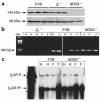beta(3)-adrenoceptor deficiency blocks nitric oxide-dependent inhibition of myocardial contractility
- PMID: 10974023
- PMCID: PMC381285
- DOI: 10.1172/JCI9323
beta(3)-adrenoceptor deficiency blocks nitric oxide-dependent inhibition of myocardial contractility
Abstract
The cardiac beta-adrenergic pathway potently stimulates myocardial performance, thereby providing a mechanism for myocardial contractile reserve. beta-Adrenergic activation also increases cardiac nitric oxide (NO) production, which attenuates positive inotropy, suggesting a possible negative feedback mechanism. Recently, in vitro studies suggest that stimulation of the beta(3)-adrenoceptor results in a negative inotropic effect through NO signaling. In this study, using mice with homozygous beta(3)-adrenoceptor deletion mutations, we tested the hypothesis that the beta(3)-adrenoceptor is responsible for beta-adrenergic activation of NO. Although resting indices of myocardial contraction were similar, beta-adrenergic-stimulated inotropy was increased in beta(3)(-/-) mice, and similar hyper-responsiveness was seen in mice lacking endothelial NO synthase (NOS3). NOS inhibition augmented isoproterenol-stimulated inotropy in wild-type (WT), but not in beta(3)(-/-) mice. Moreover, isoproterenol increased myocardial cGMP in WT, but not beta(3)(-/-), mice. NOS3 protein abundance was not changed in beta(3)(-/-) mice, and cardiac beta(3)-adrenoceptor mRNA was detected in both NOS3(-/-) and WT mice. These findings indicate that the beta(3)-adrenergic subtype participates in NO-mediated negative feedback over beta-adrenergic stimulation.
Figures




References
-
- Hare JM, Colucci WS. Role of nitric oxide in the regulation of myocardial function. Prog Cardiovasc Dis. 1995;38:155–166. - PubMed
-
- Hare JM, Loh E, Creager MA, Colucci WS. Nitric oxide inhibits the contractile response to β-adrenergic stimulation in humans with left ventricular dysfunction. Circulation. 1995;92:2198–2203. - PubMed
-
- Hare JM, et al. Contribution of caveolin protein abundance to augmented nitric oxide signaling in conscious dogs with pacing-induced heart failure. Circ Res. 2000;86:1085–1092. - PubMed
-
- Gyurko R, Kuhlencordt P, Fishman MC, Huang PL. Modulation of mouse cardiac function in vivo by eNOS and ANP. Am J Physiol Heart Circ Physiol. 2000;278:H971–H981. - PubMed
Publication types
MeSH terms
Substances
Grants and funding
LinkOut - more resources
Full Text Sources
Molecular Biology Databases

